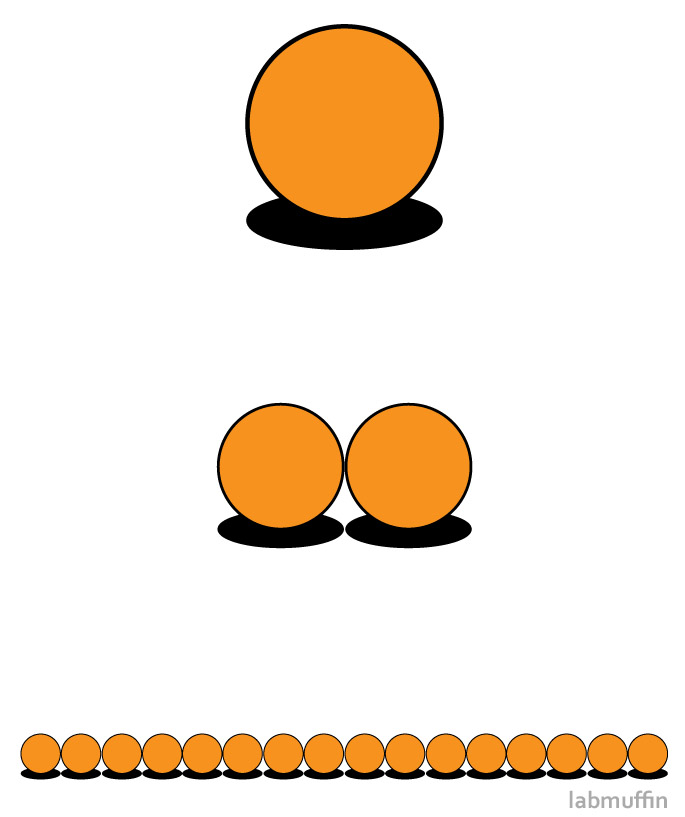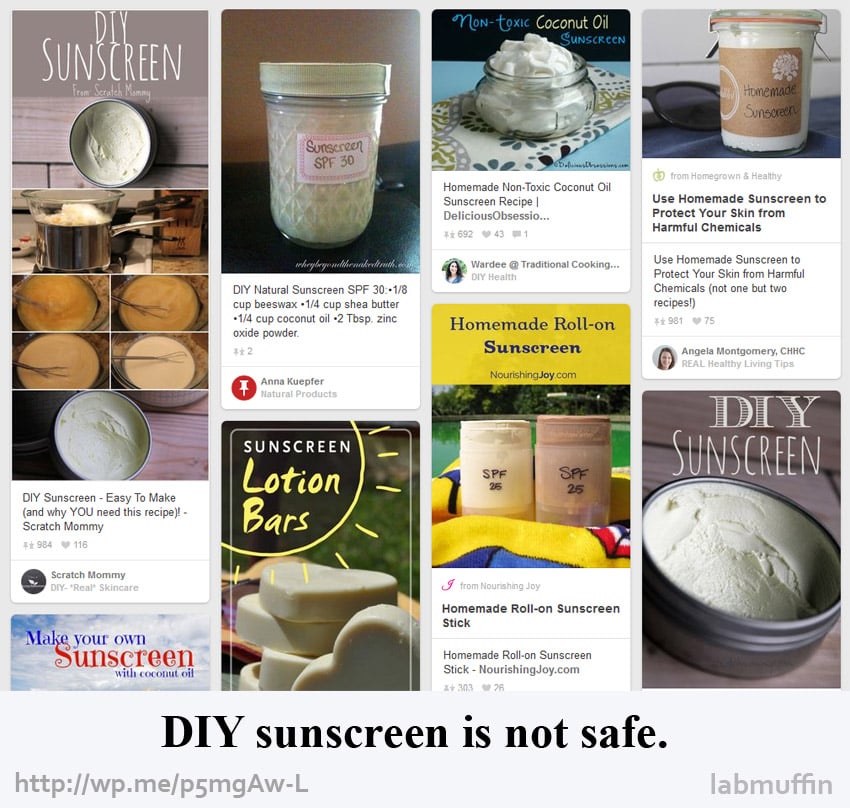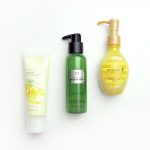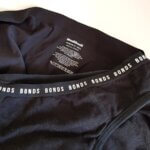You may have seen DIY sunscreen recipes going around on blogs and Pinterest, promising safe sun protection with gentle, natural ingredients. Generally the ingredients will be zinc oxide, a popular physical sunscreen ingredient (often in the form of diaper rash cream), and some plant oils such as coconut oil.
Now, I am partial to a bit of DIY skincare. I love homemade masks and keep 5 different oils in my bathroom cabinet. But I will never, ever rely on homemade sunscreen. Why? Because it’s not safe. Here’s the low-down:
SPF is about proven performance
You’ve probably heard of SPF, a number which tells you how much protection a sunscreen gives – for example, a sunscreen with an SPF of 30 blocks 97% of sunburn-causing UV rays if properly applied, and lets your skin handle 30 times more UV before burning.
The SPF number on each commercial sunscreen is not determined based on the recipe. A scientist will take the sunscreen, spread it over a live human guinea pig, and measure how much protection it gives.
However, the vast majority of DIY sunscreen recipes have never been properly tested, beyond “I put it on little Jimmy and he didn’t get burnt”. Even if a DIY sunscreen recipe had been tested to be a certain SPF, there’s no guarantee that yours would also be the same SPF. Additionally, there’s no stability testing (or even stabilisers in most recipes), so there’s no guarantee that you’ll get the same results each time you use it.
You can’t predict performance from a recipe
A lot of DIY sunscreen recipes base the amount of the sunscreen ingredient (zinc oxide) on the percentages used in commercial products. (If you see a DIY sunscreen recipe without zinc oxide, it definitely doesn’t do anything! Carrot seed oil is NOT an effective sunscreen.) There are a few sun protection calculators on the internet where you can type in the amount of each ingredient you’re using, and it’ll spit out an approximate SPF value. One of the most popular calculators is the BASF sunscreen simulator.
This sounds pretty neat in theory, right? Unfortunately, reality isn’t quite so convenient. As the disclaimer on the BASF calculator states:
it does not replace the actual formulation work and in vivo SPF testing of the final product… many factors may affect processing or application/use.
The same ingredients can give a different product
Let’s take a look at Invisible Zinc SPF 50+ 4HR Water Resistant Lotion. It has 22% zinc oxide as the sole sunscreen ingredient. The BASF SPF calculator predicts that 22% zinc oxide will give…about SPF 15. (Whaaaaat.)
The reason for the discrepancy? There’s a lot of variation in formulation, even with the same ingredients. Imagine baking a cake by beating 3 tablespoons of butter, a cup of sugar, 3 eggs and 2 cups of flour then baking at 180 °C for an hour, versus taking the same ingredients and stirring them with a skewer and pouring it onto a plate. The result is… a tad different!
Particle size and clumping
One of the biggest issues with predicting protection from percentages is that particle size and clumping make a big difference in how much protection you get. Zinc oxide and titanium dioxide come with different sized particles, which means different spread.
Imagine placing an orange on your stomach and lying in the sun. You’d see an orange-sized circle of shade on your skin. Now imagine cutting the orange in half and placing the halves on your skin – same amount of orange, but more protection. Now imagine smooshing up the orange into a paste and smearing it thinly over your torso – you’d get heaps more coverage!
This is a little like how particle size works – the smaller the individual zinc oxide particles, the greater the coverage. The diaper rash creams frequently used in DIY sunscreen recipes aren’t sold with particle size in mind, so you have no idea how spreadable the zinc oxide in them is.
Now, even if you can get zinc oxide of the same particle size as your favourite sunscreen, you’re not out of the woods yet! Your next issue is clumping. If the particles aren’t distributed evenly in your DIY sunscreen, it’ll be sitting on your skin like one big orange, and this uneven distribution isn’t always easy to see with your eyes.
Inconveniently, DIY sunscreen faves zinc oxide and titanium dioxide tend to clump in recipes if you don’t use high tech heavy equipment (no, a household blender will not cut it). And coconut oil, the most popular base for homemade sunscreen, isn’t good at unclumping physical sunscreen particles, even if you have the hardcore machinery. This means you’ll get patchy coverage – some bits of your skin will be protected, while other bits remain unprotected…or worse. And remember, UVA is the “silent killer” – you don’t have to get a sunburn to receive a dangerous dose of melanoma-causing UVA.
Oils can make you more prone to sun damage
Do you remember old-school tanning? You cover your skin in baby oil and lie in the sun for a nice, even, carcinogenic tan. The advice was actually pretty accurate – oil smooths down your skin, letting the UV rays penetrate better and speeding up your skin damage. This means using oils as the base in a DIY sunscreen is not a good idea. If you’re spreading coconut oil on your skin and the zinc oxide is giving you patchy coverage, that means the bits that *aren’t* covered are getting a bigger dose of cancer-causing UV than if you went out with bare skin!
Don’t rely on DIY sunscreen
Use store-bought sunscreen – it’s safe and effective. Homemade DIY sunscreens are extremely unlikely to work anywhere near as well. Store-bought sunscreen can be expensive, yes, but there’s a reason why you should invest in it – cancer treatment costs more. If you can’t use commercial sunscreen for whatever reason (sensitivities etc.), you can still protect yourself with a hat, some sunglasses, UV-blocking clothing and some shelter.
References
Personal Care Truth – The Trouble with Making Your Own Sunscreen
Allure – Homemade Sunscreens Don’t Work
[lastupdated]









I have not seen this around! But wow! DIY sunscreen does not sound like a good idea. Store bought sunscreen is (or should be) lab tested and more reliable. And pretty inexpensive. I don’t know why anyone would want to make their own haha.
Store-bought sunscreens in developed countries are all lab-tested, as far as I’m aware! I think people are motivated to try this sort of thing because they think they’re avoiding harmful chemicals, when in fact they’re not avoiding anything bad and actually exposing themselves to harmful UV in the process. The “Natural Is Better” line of thinking can be very seductive!
Wowww I cannot believe people try to make their own sunscreen!
Really good point about the oils making you more prone to sun damage – scary stuff!
As someone who burns just by looking at the sun, I just would not risk my skin (and potentially health) by making my own sunscreen.
Thank you for such an informative post Michelle – as always! I always find them super interesting to read and learn from. I actually haven’t seen any DIY sunscreen recipes, but will definitely not be trying them out!
Tasha // shiwashiful.
Yes!!!! I hate seeing these kinds of DIYs. I was really annoyed when I saw Into the Gloss post a DIY recipe for sunscreen. I unfollowed after seeing their “apology”. They need to be more careful with what they post since they are so well known :/
Fabulous article Michelle. I have seen lots of these recipes floating around and have always wondered how effective they would be. I must say that I have never been inclined to try it for myself though. I would much rather buy my sunscreen as I don’t want to risk my health especially as I have the fairest skin and need the highest SPF to ensure I don’t burn.
Thanks for this post, so good to know! Some things just can’t be DIY’d….
Haha yes – I’d put almost all therapeutics in that category!
Heya. I don’t get the oils facilitate burning (?) part, though. Don’t manufactured/storebought sunscreens contain oils as well? Especially the purely physical ones that tend to be notoriously greasy (and the chemical ones too, often silicone-based).
Any information about whether silicones also facilitate/not absorption of UV? Or whether water-based sunscreens (do they actually exist?) is the only way to go?
Storebought sunscreens do contain oily ingredients, but they’ve been formulated to give a good spread of sunscreening ingredients – homemade ones are likely to have big gaps where the oil will act like a big magnifying glass.
While I love DIYing I skipped this one as I’m no chemist! I’m also allergic to most sunscreens, they make me burn!!
That must be so annoying! Are you sensitive to physical-only sunscreens?
The real truth is the results. Chemical sunscreen everyday can give you bad longterm problems and liver problems and cancer. Zinc DIY sunscreen WILL not give you cancer and can be easily spread on your face easily and it does not make me sick internally like chemicals do for me! I also get no tan from the zinc coconut oil.
Zinc diy formulas have changed my life I am glad most of you will stick to chemical sunscreen . More zinc for me yay!
There are zero cases where chemical sunscreens have caused long term problems or cancer. Zinc DIY sunscreen will definitely give you cancer if it doesn’t work properly, which is likely!